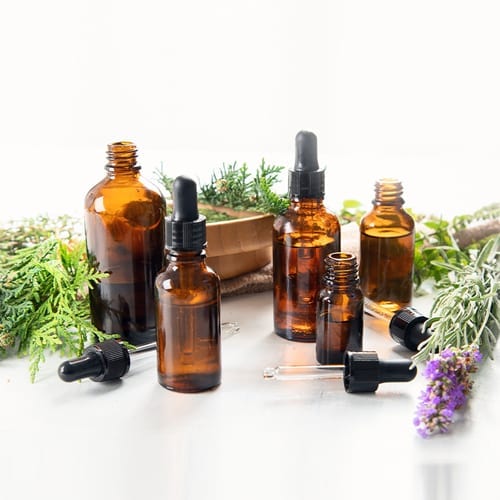
Essential oils can offer a multitude of benefits for humans, but can they help our pets – and especially man’s best friend – too? Smell is an essential primeval sense, in fact, the first major nerve that enters the brain can detect a scent, and our emotions are strongly influenced by it.
Good smells can calm and relax us, as well as bring other benefits, while bad smells can do the opposite. Our pets, of course, also use their sense of smell, but it overpowers our own dramatically. Scientists say it’s anywhere from 10,000 to 100,000 times as acute. Dogs can detect some odors in parts per trillion, which means while we can usually detect if our morning coffee has had a teaspoon of sugar added to it, a dog could detect a teaspoon of sugar in a million gallons of water, or two Olympic-sized pools worth. Our pets use their sense of smell to gain all sorts of complex information from the environment and that information is used to calculate and predict what states of energy and response they should adopt.
While aromatherapy can be of great use to animals, before attempting it, it’s important to know how to properly use essential oils so that they aren’t harmed in the process. Essential oils are absorbed by inhalation, ingestion, and contact with the skin. They enter the bloodstream very quickly and are distributed to various tissues. As with all compounds, some have a biological affinity for specific tissues, and those who are aromatherapy experts can use that property to select oils that will target specific tissues. It’s very important to remember that very small amounts of these compounds can have powerful biological effects on every system of the body. For example, lavender oil has powerful effects on the brain and creates a calming sensation. Tiny amounts of lavender oil can be used to calm pets or make them feel sleepy, such as when traveling, for example.
Something else that’s important to know is that while there are some oils that are fine for dogs and horses, they often aren’t good for cats, rabbits or birds, simply due to the smaller size of their bodies. If you want to use them on these smaller animals, be sure to speak with your veterinarian first.
30 Essential Oils You Should Never Use On Any Animal
- Anise (Pimpinella anisum)
- Birch (Betula)
- Bitter Almond (Prunus dulcis)
- Boldo (Peumus boldus)
- Calamus (Acorus calamus)
- Camphor (Cinnamomum camphora)
- Cassia (Cassia fistula)
- Chenopodium (Chenopodium album)
- Cloves (Syzygium aromaticum)
- Garlic (Allium sativum)
- Goosefoot (Chenopodium murale)
- Horseradish (Armoracia rusticana)
- Hyssop (Hyssopus sp. with the exception of Decumbens)
- Juniper (Juniperus sp. with the exception of Juniper Berry)
- Mugwort (Artemisia vulgaris)
- Mustard (Brassica juncea)
- Oregano (Origanum vulgare)
- Pennyroyal (Mentha pulegium)
- Red or White Thyme
- Rue (Ruta graveolens)
- Santolina (Santolina chamaecyparissus)
- Sassafras (Sassafras albidum)
- Savory (Satureja)
- Tansy (Tanacetum vulgare)
- Tea Tree Oil (Melaleuca alternifolia)
- Terebinth (Pistacia palaestina)
- Thuja (Thuja occidentalis)
- Wintergreen (Gaultheria procumbens)
- Wormwood (Artemisia absinthium)
- Yarrow (Achillea millefolium)
There are some essential oils that are considered safe for dogs in very small amounts, however, it’s important to take certain steps first so they can get used to the scent, and so that you’ll be aware of how that scent will affect them.
Choosing The Best Essential Oils
Using a poor quality essential oil could be ineffective or even harmful. These oils have been distilled from poor crops and may have additives, have been handled improperly or are old.
There are a number of signs to look for that will help ensure that your oil is high quality and 100% pure.
- When shopping online, be sure the online store includes the common name of the oil as well as the Latin name. If the Latin name isn’t there, it may actually be a non-essential oil that simply has perfume added to give it its scent. For example, when purchasing peppermint essential oil, look for something that reads: Peppermint, Organic, Mentha x piperita.
- If the oil is very low priced, there’s a good chance that it isn’t of good quality as it takes a surprisingly large amount of plant to produce them. The quantity may decrease or increase depending on the type, but consider that just one pound of lavender oil requires over 150 pounds of lavender flowers, and more than 250 pounds of peppermint leaves are needed to make pound of peppermint essential oil.
- As essential oils are created from plants, buying an organic oil is important in order to avoid potential pesticide contamination. While most brands carry the official USDA seal, you should also look for an oil that is labeled “wild-crafted.” That means that the plant used to make the oil was harvested in the wild, and not farmed – which indicates that it hasn’t been sprayed with chemicals
- The label should always indicate if the essential oil is 100% pure essential oil. If it doesn’t, that means that it’s been altered, or mixed with something else. For an oil to be effective, it needs to be pure.
- You can also test your oil for purity once you’ve purchased it. To do so, simply place a single drop onto a piece of white paper and then allow it to dry. If an oil ring is left behind, it’s not a pure essential oil. There are exceptions (sandalwood, patchouli oils and German chamomile) as some oils are deeper in color and heavier in consistency and can leave a slight tint behind, though it shouldn’t be greasy.
Essential Oil Therapy Introduction
Before using any oil on your dog, try simply holding a bottle of it in your hand with your four-legged friend in the same room. Allow the dog to approach the new item, but avoid letting it actually smell the bottle just yet. Remember that dogs are scent-driven animals, and you don’t want to overwhelm them with too much too fast. If your dog seems okay with the scent, you can let it smell from the bottle. Give it a day or two and try it again, then moving forward only if everything is okay. At that point, you can diffuse it in a room, adding a couple of drops to a diffuser, but do not apply it topically. The idea is to begin aromatherapy to help your dog feel good, rather than starting a routine when you are trying to resolve an issue.
If your dog shows no signs of irritation or other negative effects and you want to use it topically, then you can start with a single drop of oil diluted in 50 drops of a carrier oil (such as grapeseed oil or olive oil) and apply it to the back of its neck.
7 Best Essential Oils That Are Generally Safe For Dogs
Veterinarians are skilled in the diagnosis of disease in animals and should always be consulted when your pet is displaying severe or persistent symptoms, however, the following essential oils can be used in first aid and are generally considered safe for short-term use.
1. Cedarwood oil
Cedarwood, or cedar oil, (latin name Cedrus Atlantica or deodara, is best known for its powerful ability to repel and kill pests like fleas. It has a wide range of beneficial properties, including being an antiseptic for the lungs and an expectorant for coughs like a kennel cough. It stimulates circulation and is good for resolving stiffness in dogs that commonly occurs with increasing age, as well as arthritis and back pain. It may also help eliminate dandruff, strengthen kidney function and be used as a general calming tonic, calming, especially for nervous aggression, dogs who are especially shy or timid, or those who need a greater sense of inner security, including those that have severe separation issues.
2. Lavender oil
Lavender oil, Latin name Lavandula angustifolia, is considered one of the most versatile essential oils, creating a sense of peace and harmony and offering a calming effect on dogs, and their humans too. This oil is soothing to the central nervous system and can only be used effectively to help a dog get used to a safe space. It can ease car ride anxiety and car sickness as well as help with allergies and insomnia. A 2006 study found that using lavender essential oil on dogs reduced their movement and vocalization during travel. The author of the study concluded: “Traditional treatments for travel-induced excitement in dogs may be time-consuming, expensive or associated with adverse effects. Aromatherapy in the form of diffused lavender odor may offer a practical alternative treatment …”
This is a good, safe oil to use anytime your dog will be in a stressful situation, like a trip to the vet or when traveling, as well as during training in order to slow hyperactivity.
3. Lemongrass oil
Lemongrass oil is well-known to repel insects like fleas, ticks, and mosquitoes, due to its high citral and geraniol content. It can also be used to kill fleas. Add 2-3 drops of the oil to water in a spray bottle, and then apply the spray to your pet’s coat and massage through. Not only will it keep those ticks and fleas away, it can improve the condition of your dog’s skin.
4. Citronella oil
Citronella oil is also known for its insect-repelling abilities. Don’t use those chemical-filled, store-bought citronella candles though. When you think of citronella oil, you probably picture a candle burning on a humid summer’s evening keeping mosquitoes at bay, but it also has a scent that overpowers humans, so just think about what it will do to your dog. But when using a pure essential oil, not only is it considered totally non-toxic, but when used in small amounts, it won’t overpower yet the smell will still ward off insects. It can not only keep ticks and fleas away, but it’s been found to be very effective on a species of mosquito known as Aedes Aegypti whose bite causes the dreaded Yellow Fever. You can use it like lemongrass by adding 2 to 3 drops to water in a spray bottle and massaging through your dog’s coat.
5. Frankincense oil
Frankincense is less potent than many other essential oils and is generally considered to be an excellent all-around oil. It can help to calm your pet and ease anxiety, and it’s even been used to help in some cases of cancer as well as reducing tumors, external ulcers and strengthening the immune system. As few studies have been conducted using frankincense specifically on animals, if your dog has cancer, be sure to discuss using frankincense oil with your vet.
Great care must be taken not to make medical claims, so my research led me to specific studies involving human cancer since fewer studies with essential oils are done with animals. In one study, frankincense from Boswelia carteri was used for human bladder cancer to see if it would be effective as an anti-tumor agent and results showed great promise. Research from the University of Leicester showed that frankincense may be a potential treatment for breast, brain, colon, stomach and pancreatic cancers as well.
6. Spearmint oil
Spearmint oil, when used as directed by your vet, can help support weight loss in your dog and also address issues like diarrhea and colic. It’s known to aid in balancing the metabolism and stimulating the bladder. When used diluted in small amounts over the short term, it’s known to help a wide range of gastrointestinal issues in dogs.
7. Cardamom oil
Cardamom is well-known for its benefits to the digestive and respiratory system. It’s generally gentler and safer for children, and the majority of experts consider it safe for dogs. It helps to maintain optimal gastrointestinal balance, ease indigestion and calm stomach upset as well as support respiratory health and promote better breathing. It can uplift the mood of a sullen or anxiety-ridden dog. It’s excellent for humans as well as their pets for regaining control when feeling overwhelmed and particularly beneficial for dogs with a long history of aggression. Diffusing it can help create a calming environment for your pet.
Essential Oils & Pet Safety
Before embarking on essential oil use around pets, consult your veterinarian. It is important to always dilute essential oils before use in a carrier oil – a rate of 1 drop of essential oil to 50 drops of carrier oil is usually sufficient. Cats are much more susceptible to essential oils and so essential oils should not be used around cats.





